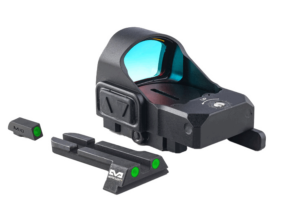
By Kat Ainsworth Stevens
Contributing editor
Carrying a firearm for self-defense purposes has been going on not for decades but for centuries.
For almost as long, iron sights have been the obvious go-to on handguns being carried for self-defense. But as time has gone on advances have been made in technology and training which is why three-dot sights now lean toward a blacked-out rear sight with a dot only in the front and tritium night sights are so popular. More recent than alterations to iron sights – many of which would be more accurately referred to as plastic sights – is the proliferation of red dot sights (RDS) on carry guns. Should you make the change to RDS? Check out the pros and cons.
Pros

RDS have come a long way. Once seen as only for long guns they eventually shrank down for use on pistols, where they were typically thought of as the purview of competition shooters. Today RDS have become increasingly common on carry guns; once you never would have seen them in handgun classes geared toward self-defense but now they’re everywhere.
Perhaps the biggest pro of using an RDS is the speed with which you can get on target. Instead of lining up irons you’re acquiring a red dot in the center of the glass, something you can learn to do with ease. Some shooters say the dot also helps them not be so target-focused due to the way the illuminated spot draws their eyes.
Other RDS benefits include having an easier time making longer-range shots and greater visibility for less-than-perfect eyes. RDS are simple to use once you get the hang of them and are do give your eyes a break. Most models can be used as a ledge to rack your slide one-handed or on an object in a self-defense scenario, something you can technically do with many irons but with more of a struggle. Using an RDS on your carry gun gives you many advantages, in fact there are some who say those advantages are unfair. But as the late Col. Jeff Cooper once said, “Maybe the first thing one should demand of his sidearm is that it be unfair.”

Cons
One of the first things mentioned when it comes to the downsides of using an RDS has to do with batteries. What if your battery dies at an inopportune moment? The simplest answer is to maintain those batteries rather than giving them a chance to die. In reality, the battery life of most RDS’ on the market is extraordinary. That said, using iron sights made for co-witnessing with an RDS is a good way to solve the potential problem. If your RDS batteries did die you’d have irons to fall back on.

Another issue with RDS is that they’re, well, red. Those of us with an astigmatism often have a halo-effect problem with red dots. However, there are green dot options on the market and the change of color typically solves the halo issue.
Using an RDS would require finding a holster compatible with whatever RDS you’re using, something that can be flat impossible. Holster manufacturers are coming out with more options for gun owners using an RDS but they’re not available for every gun out there, not yet.
RDS can also be price-prohibitive. Those Trijicon RMRs aren’t cheap.
Yes, making the changing to a red dot would require practice. You aren’t going to master using an RDS overnight. It has to be zeroed at a specific distance just like any optic and you’ll have to figure out point of aim versus point of impact (but that’s the case with dots, too, it’s just a different). You have to get your eyes used to acquiring it. And if it isn’t motion activated, then what? Are you supposed to turn it on and off every time you want to use your gun? That last one falls under “do your research before choosing an RDS.”

Bottom Line
Maybe you’d rather not rely on electronics of any kind on your carry gun, and that’s fine. Or perhaps you think you’ll gain an edge with an RDS and you want that edge. It’s true, you might shave some time off how long it takes you to draw your firearm and get a shot on target, and that can be worth it (but it takes practice). If you’re against RDS it might be worth at least trying it out so you have hands-on experience. Personally, I have guns with RDS and without RDS and began using RDS for handgun hunting long before I even considered putting them on carry guns.
Whatever you choose to do is up to you and perfectly fine. Every shooter has different needs and skills. Do take the time to be a well-rounded shooter willing to try out various pieces of gear. You never know what you could learn.



